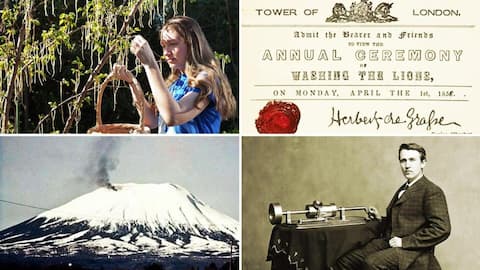April Fools' Day: 6 of the greatest pranks in history
What's the story
April 1, a day synonymous with pranks and jests, has a long-standing tradition across many cultures. Each year, people around the world celebrate April Fools by playing practical jokes on friends, family, and sometimes even strangers. Throughout history, some pranks have stood out for their creativity and scale. Here are six of the most legendary April Fools' Day pranks in history.
Prank 1
Swiss Spaghetti Harvest (1957)
On April Fools' Day 1957, BBC's Panorama aired a three-minute hoax report, depicting a family in southern Switzerland harvesting spaghetti from their "spaghetti tree." Unfamiliar with spaghetti's ingredients led viewers to seek guidance from the BBC on growing their spaghetti trees. Thousands fell for the hoax, prompting later recognition by CNN as "the biggest hoax" by a reputable news outlet.
Prank 2
The Left-Handed Whopper (1998)
In 1998, Burger King ran a full-page ad on USA Today introducing the "Left-Handed Whopper," specially designed for 32 million left-handed Americans. Although the burger was unchanged, the prank sparked excitement, prompting both left-handed and right-handed customers to make specific orders. The humorous campaign garnered widespread attention and showcased the power of creative marketing to engage consumers.
Prank 3
Eruption of Mount Edgecumbe (1974)
On April 1, 1974, Sitka, Alaska residents awoke to smoke billowing from nearby Mount Edgecumbe, sparking fears of an eruption. However, it was a prank by local Oliver Bickar, who ignited hundreds of tires in the crater. The spectacle garnered national attention, amusing and relieving residents. Bickar's elaborate hoax showcased the town's sense of humor while leaving onlookers in awe of the prankster's creativity.
Prank 4
Taco Liberty Bell (1996)
In 1996, Taco Bell took out full-page ads in several major US newspapers, announcing that they had purchased the Liberty Bell. The ad claimed that as a gesture of patriotism, the fast-food chain had acquired the historic landmark and renamed it the "Taco Liberty Bell," sparking outrage and displeasure. Later, Taco Bell revealed that it was all a prank, stirring amusement across the nation.
Prank 5
The BBC's Smell-O-Vision (1965)
In 1965, the BBC featured a hoax on Tomorrow's World, introducing "Smell-O-Vision," claiming viewers could smell aromas through their TV sets. Despite its absurdity, many were intrigued, prompting inquiries about purchasing the device. This prank highlighted the public's fascination with emerging technologies and the influence of media. The hoax showcased the BBC's ability to captivate audiences and spark curiosity through innovative storytelling.
Prank 6
Google gulp, (2005)
In 2005, Google introduced Google Gulp, a fictitious beverage promising enhanced intelligence and search engine optimization. They claimed it analyzed your DNA and adjusted your brain chemicals. It was available in flavors like glutamate grape and sero-tonic water. To "obtain" the drink, users were comically instructed to return bottle caps to local grocery stores, adding to the playful hoax.
